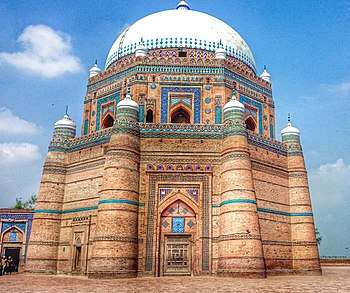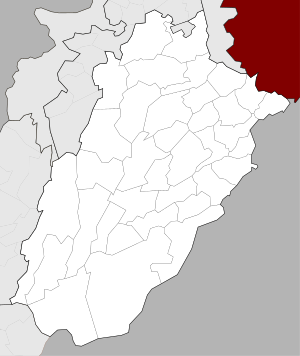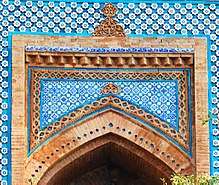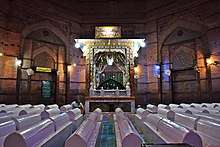Tomb of Shah Rukn-e-Alam
| مقبرہ شاہ رکن عالم | |
 The shrine of Rukn-e-Alam is one of southern Punjab's most important Sufi shrines | |
 Location in Punjab, Pakistan  Tomb of Shah Rukn-e-Alam (Pakistan) | |
| Coordinates | 30°11′56″N 71°28′17″E / 30.19889°N 71.47139°ECoordinates: 30°11′56″N 71°28′17″E / 30.19889°N 71.47139°E |
|---|---|
| Location | Multan, Punjab, Pakistan |
| Type | Sufi shrine |
| Completion date | 1324 C.E. |
The Tomb of Shah Rukn-e-Alam (Urdu: مقبرہ شاہ رکن عالم) located in Multan, Pakistan, is the mausoleum of the Sufi saint Sheikh Rukn-ud-Din Abul Fateh. The shrine is considered to be the earliest example of Tughluq architecture,[1] and is of the most impressive shrines in the Indian subcontinent.[2] The shrine attracts over 100,000 pilgrims to the annual urs festival that commemorates his death.[3]
Location
The tomb is located in the ancient city of Multan, in central Pakistan. The tomb is situated at the northwestern edge of the Multan Fort.
History
The tomb was built between 1320 and 1324 CE by Ghiyath al-Din Tughluq in the pre-Mughal architectural style.[3] The tomb is considered the earliest example of Tughluq architecture, and pre-dates Tughluq monuments in Delhi.[1]
The tomb was built when Ghiyath al-Din served as governor of Dipalpur, and likely was intended to serve as a tomb for himself,[4][3] before he became Emperor of the Delhi Sultanate. Rukn-e-Alam had initially been buried in the Shrine of Bahauddin Zakariya,[4] however, the present tomb was gifted by Muhammad bin Tughluq to the descendants of Rukn-e-Alam,[5] who had his remains interred in the shrine in 1330.[4]
Layout
The shrine's layout is typical of Suhrawadi tombs, with three entrances, a western-facing mihrab, and an original main entrance on the southern axis that featured a small vestibule.[4] The main entrance has since been shifted to the east, in an attempt to align the shrine's axises with Mecca, in accordance with orthodox interpretations of Islam.[4]
Architecture


The mausoleum features a syncretic architectural style that synthesizes elements of foreign and native decorative elements.[4] Multan had strong links to Persia and Afghanistan - links which are reflected in the heavy influence of Central Asian and Persian architectural styles found at the tomb, such as the use of brick, glazed tiles, and wooden roofs.[1] The shrine represents the culmination of Multani funerary architecture that began with the Shrine of Khalid Walid near Kabirwala.[7]
Mausoleum
The mausoleum is a three-tiered structure. Though the second octagonal tier is typical of Multan,[1] the first tier in the shape of an octagon differs from the nearby Shrine of Bahauddin Zakariya and other earlier shrines which rests upon a square shaped base.[1]
The first tier is 15 metres in diameter, and features walls 4 feet thick. The first tier features bands of timber that create a visual break in the exterior brickwork.[1] The octagonal first tier is buttressed by small minaret-shaped towers in each of its 8 corners that provide support to the structure, and narrow as they rise and surpass the height of the first tier.[3]
A second octagon rests upon the first tier that features small domes in each of the eight corners of the building. A third tier rests above the second, and is formed by a dome of 15 metres in diameter.[3] The entire structure is 35 metres tall,[3] with sloping walls. The dome is capped by a structure similar to an amalaka found on Hindu temples.[8]
Decorative elements
The mausoleum is built entirely of red brick, bounded with beams of shisham wood, which have turned black over the centuries. The exterior is elaborately ornamented with carved wooden panels, carved brick, string-courses and battlements. Buttresses, turrets, and crenellations at the top of the shrine reflect the influence of Tughluq military architecture on even non-military buildings.[9]
The exterior is further embellished with regional-style tile-work in floral, arabesque, and geometric motifs with dark blue, azure, and white tiles - all of which contrast the deep red finely polished bricks. The white dome is decorated with blue tile-work along its lower perimeter.[3]
Interior

The shrine's vast interior features no internal buttresses, nor any interior structural elements to support the interior space,[6] which results in a vast interior space. The interior was initially decorated with elaborate tile work, which was subsequently covered in plaster,[6] though vast interior of the mausoleum is now largely bare.[3] Niches at the ground level serve to enlarge the interior space further.[6]
The carved wooden mihrab is considered to be one of the earliest examples of its genre.[3] The sarcophagus of Rukn-e-Alam is slightly off-centre, and is surrounded by the graves of 72 of his relatives,[4] which allude to the 72 martyred companions of the Prophet Muhammad's grandson, Imam Hussein, at the Battle of Karbala in 680 CE.
Conservation
In the 1970s, the mausoleum was thoroughly repaired and renovated by the Auqaf Department. The entire glittering glazed interior is the result of new tiles and brickwork done by the Kashigars, or tile makers, of Multan.[10]
The tomb is on the tentative list as a UNESCO World Heritage Site.[11]
Gallery
 Detail of the shrine's carved brickwork
Detail of the shrine's carved brickwork The shrine is illuminated at night
The shrine is illuminated at night The tomb in 1865
The tomb in 1865 Underside of the shrine's dome
Underside of the shrine's dome- Devotees inside the shrine
 External view of the shrine
External view of the shrine The shrine's exterior is embellished with a variety of decorative elements
The shrine's exterior is embellished with a variety of decorative elements- A view of the shrine from its courtyard
References
- 1 2 3 4 5 6 Bloom, Jonathan (1995). The Art and Architecture of Islam 1250-1800. Yale University Press. ISBN 9780300064650. Retrieved 9 September 2017.
- ↑ Asghar, Muhammad (2016). The Sacred and the Secular: Aesthetics in Domestic Spaces of Pakistan/Punjab. LIT Verlag Münster. ISBN 9783643908360.
- 1 2 3 4 5 6 7 8 9 "Tomb of Shah Rukn-e-Alam". UNESCO. Retrieved 8 September 2017.
- 1 2 3 4 5 6 7 Khan, Hassan Ali (2016). Constructing Islam on the Indus: The Material History of the Suhrawardi Sufi Order, 1200–1500 AD. Cambridge University Press. ISBN 9781316827222.
- ↑ Bunce, Fredrick W. (2004). Islamic Tombs in India: The Iconography and Genesis of Their Design. D.K. Printworld. ISBN 9788124602454.
- 1 2 3 4 Hillenbrand, Robert (2004). Islamic Architecture: Form, Function, and Meaning. Columbia University Press. ISBN 9780231101332.
- ↑ Petersen, Andrew (2002). Dictionary of Islamic Architecture. Routledge. ISBN 9781134613656. Retrieved 15 September 2017.
- ↑ Prakash, Vikramaditya (2011). A Global History of Architecture. John Wiley & Sons. ISBN 9780470902486.
- ↑ Gommans, J.J.L. (2003). Mughal Warfare: Indian Frontiers and Highroads to Empire 1500–1700. Routledge. p. 143. ISBN 9781134552764. Retrieved 9 September 2017.
- ↑ http://www.heritage.gov.pk/html_Pages/historic_multan.htm Historic Multan
- ↑ http://whc.unesco.org/en/tentativelists/1884/
External links
![]()
- SN Bukhari (2009-08-24). "Tomb of Shah Rukne Alam Multan". YouTube. Retrieved 2013-12-07.
